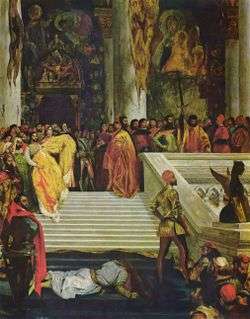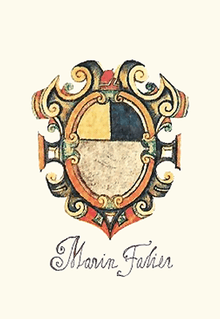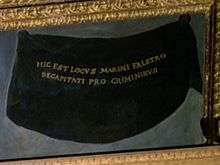Marino Faliero
Marino Faliero (1274 – 17 April 1355) was the 55th Doge of Venice, appointed on 11 September 1354.
Marino Faliero | |
|---|---|
.jpg) Marino Faliero, Dux LV by Francisco Pradilla Ortiz (1883, Museo del Prado) | |
| 55th Doge of Venice | |
| In office 11 September 1354 – 15 April 1355 | |
| Preceded by | Andrea Dandolo |
| Succeeded by | Giovanni Gradenigo |
| Personal details | |
| Born | 1274[1] Venice, namesake Republic |
| Died | 17 April 1355 (aged 81) Venice, namesake Republic |
| Spouse(s) | Tommasina Contarini Alvica Gradenigo |
| Children | 2 |
| Profession | Patrician, statesman |
He was sometimes referred to simply as Marin Falier (Venetian rather than standard Italian) or Falieri.[2] He was executed for attempting a coup d'etat.
Biography


Faliero was a naval and military commander and then a diplomat before being elected doge in succession to Andrea Dandolo.[3] The populace of Venice was at that time disenchanted with the ruling aristocrats who were blamed for a recent naval defeat by the fleet of the Republic of Genoa at the 1354 Battle of Portolungo during the Third Venetian–Genoese War.[3] Faliero learned of his election while he was on a diplomatic mission to the papal court at Avignon.[3]
Within months of being elected, Faliero attempted a coup d'etat in April 1355, aiming to take effective power from the ruling aristocrats. According to tradition, this came about because the dogaressa, Faliero's second wife, Aluycia Gradenigo, had been insulted by Michele Steno, a member of an aristocratic family,[4] but in a study of doges of Venice Antonella Grignola suggests that Faliero's move was consistent with a prevailing trend in Italian cities to move away from oligarchic government to absolute, dynastic rule.[4]
The plot was badly organised, with poor communication between the conspirators, and was quickly discovered. Faliero pleaded guilty to all charges and was beheaded on 17 April[2][5] and his body mutilated. Ten additional ringleaders were hanged on display from the Doge's Palace in St Mark's Square.[6]
Legacy

Faliero was condemned to damnatio memoriae, and accordingly his portrait displayed in the Sala del Maggior Consiglio (Hall of the Great Council) in the Doge's Palace was removed and the space painted over with a black shroud, which can still be seen in the hall today. A Latin language inscription on the painted shroud reads: Hic est locus Marini Faletro decapitati pro criminibus ("This is the space reserved for Marino Faliero, beheaded for his crimes").[4]
The story of Faliero's failed plot was later made into plays by Lord Byron (in 1820) and Casimir Delavigne (in 1829).[7][8] The latter's version was adapted into an eponymous opera scored by Gaetano Donizetti in 1835.[8] All three present the traditional story that Faliero was acting to defend his wife's honour.[7][8] Prussian author E. T. A. Hoffmann used a different approach in his 1818 novella Doge and Dogess; German composer Robert Schumann contemplated writing an opera based on Hoffmann's story.[9]
His home, Palazzo Falier, still exists in Venice, being one of the oldest structures there.[10][11]
Notes
- "Marin Falier". Encyclopædia Britannica. Retrieved 7 March 2017.
- Chisholm, Hugh, ed. (1911). . Encyclopædia Britannica. 10 (11th ed.). Cambridge University Press. p. 148.
- Grignola, p. 48
- Grignola, p. 49
- Byron, Lord George (1842). Marino Faliero ... An historical tragedy, in fife sic acts, of Lord Byron. John Murray. p. 157.
- Norwich, pp. 223–229
- Lefevre, Carl. "Lord Byron's Fiery Convert of Revenge", Studies in Philology , Vol. 49, No. 3 (July 1952), pp. 468–487 (subscription required)
- Ashbrook, William. "Marino Faliero", The New Grove Dictionary of Opera', Oxford Music Online, accessed 17 June 2012 (subscription required)
- Jensen, Eric Frederick (13 February 2012). "Schumann". Oxford University Press.
- "Cannaregio district". VeneziaUnica City Pass. 27 February 2018. Retrieved 7 October 2019.
- Buckley, Jonathan (2013). The Rough Guide to Venice & the Veneto. Rough Guides UK. p. 129. ISBN 9781409366461.
Bibliography
- Ashbrook, William (1996). "Marino Faliero". The New Grove Dictionary of Opera.
- Brown, H. (1907). Studies in the History of Venice. London: John Murray.
- Grignola, Antonella (1999). The Doges of Venice. Venice: Demetra. ISBN 9788844014131.
- Norwich, John Julius (2003) [1977]. A History of Venice. London: Penguin. ISBN 978-0-14-101383-1.
- Lazzerini, V (1892). Genealogia d. M. Faliero. Archivio Veneto.
- — (1893) "M. Faliero avanti ii Dogado," ibid.
- — (1897) "M. Faliero, la Congiura," ibid.
- Romanin, S. (1855). Storia documentata di Venezia. lib. ix. Venice.
- Sanudo, M. (1900). Le Vite dei Dogi (Muratori fasc. ed.). Citta di Castello.
| Political offices | ||
|---|---|---|
| Preceded by Andrea Dandolo |
Doge of Venice 1354–1355 |
Succeeded by Giovanni Gradenigo |